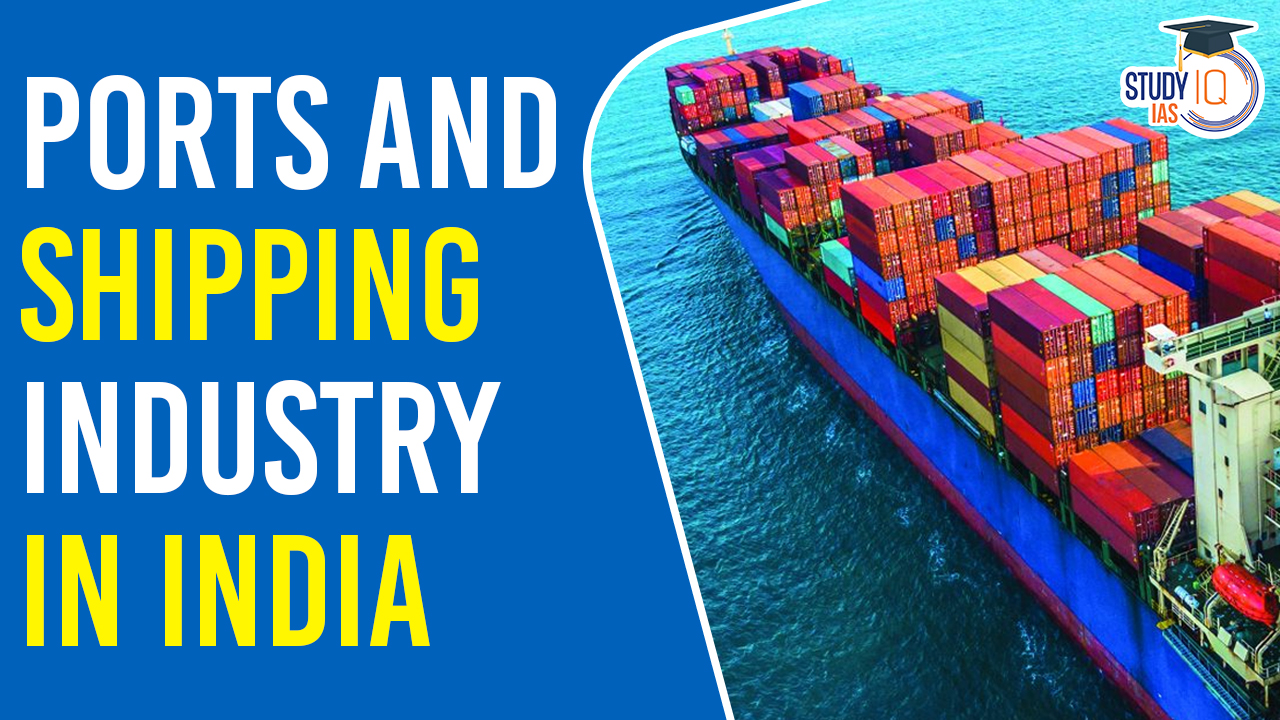Table of Contents
Ports and Shipping Industry in India
Ports and Shipping Industry in India is surging ahead, riding on the waves of economic progress. With a coastline stretching over 7,500 kilometers and more than 200 ports, India holds a strategic position in global maritime trade routes. This article delves into the significance of the Indian Ports and Shipping sector, its historical roots, current state, government initiatives, recent developments, and future prospects.
Ports and Shipping Industry in India Overview
| Aspect | Description |
| Ports Infrastructure | India has a coastline of over 7,500 kilometers and more than 200 ports, comprising 12 Major ports and numerous Non-Major ports. |
| Cargo Handling Capacity | Total cargo handling capacity is approximately 2400 million tonnes per annum (MTPA). |
| Trade Contribution | Indian ports handle about 95% (by volume) and 68% (by value) of the country’s external trade. |
| Merchant Fleet | India boasts a merchant fleet of 1491 seagoing ships with a total capacity of 13 Mn GT. |
| Global Standing | India ranks 18th in the world’s shipping tonnage and is the 16th largest maritime country globally. |
| Ship Recycling | India holds a 30% share in the global ship recycling market. |
| Government Initiatives | Foreign Direct Investment (FDI) of up to 100% is permitted for port and harbor construction projects under the automatic route.
Enterprises involved in port development enjoy a 10-year tax holiday. Various legislative measures like the Draft Indian Ports Bill 2022 aim to streamline regulations and centralize administration for better governance. |
| Infrastructure Development | Ongoing and planned projects aim to modernize ports, deepen draft, and enhance hinterland connectivity. |
| Technological Advancements | Adoption of advanced technologies such as AI, blockchain, and automation is transforming maritime operations, enhancing efficiency and safety. |
| Sustainability Efforts | The industry is transitioning towards cleaner fuels, eco-friendly practices, and carbon-neutral operations to align with global environmental goals. |
| Policy Support | Government policies provide incentives for investment, innovation, and regulatory compliance, fostering growth and competitiveness in the sector. |
| Future Prospects | Infrastructure development projects, technological advancements, and sustainability initiatives indicate a promising outlook for the industry.
Strategic partnerships and global trade dynamics position India as a key player in international shipping networks, driving growth and prosperity. |
We’re now on WhatsApp. Click to Join
Ports In India
India’s maritime landscape is dotted with major ports that serve as crucial nodes in the country’s trade network. From the bustling metropolis of Mumbai to the historic port of Kolkata, each port plays a unique role in facilitating trade and commerce. Let’s explore the salient features of India’s major sea ports, spanning both the east and west coasts.
West Coast Ports
- Mumbai Port: Situated in Maharashtra, Mumbai Port is not only India’s largest harbor but also its oldest. With three enclosed wet docks and strategic importance dating back to the era of Shivaji’s naval prowess, Mumbai Port handles a significant portion of the country’s maritime trade, including crude oil and petroleum products.
- Jawaharlal Nehru Port (Nhava Sheva Port): Located in Maharashtra, Nhava Sheva Port stands as India’s largest container port and an artificial marvel. It serves as a vital trade hub, handling a diverse range of goods from textiles to pharmaceuticals. The port’s strategic location on the eastern shore of Mumbai harbor ensures seamless connectivity to global markets.
- Kandla Port: Nestled in Gujarat, Kandla Port holds the distinction of being India’s largest port by cargo volume. Built post-independence to alleviate the burden on Karachi Port (now in Pakistan), Kandla serves as a lifeline for the nation’s trade, particularly in the western region. Its status as a tidal port enhances its operational efficiency.
- Mangalore Port: Karnataka’s pride, Mangalore Port, is an all-weather deep-water port handling essential commodities like iron ore. Its strategic location on the Arabian Sea coast makes it a key player in facilitating trade for the coastal state, contributing to regional economic development.
- Mormugao Port: Located in the scenic state of Goa, Mormugao Port is renowned as a major iron ore exporter. Apart from its commercial significance, the port serves as a tourist attraction, drawing visitors with its picturesque landscapes and rich maritime heritage.
East Coast Ports
- Kolkata Port: As India’s only major riverine port, Kolkata Port holds a unique position in the country’s maritime landscape. Situated on the banks of the Hooghly River, it has been instrumental in shaping the region’s trade dynamics, particularly in commodities like jute and tea.
- Paradip Port: Odisha’s pride, Paradip Port, stands as a testament to India’s post-independence maritime ambitions. Located at the confluence of the Mahanadi River and the Bay of Bengal, it serves as a crucial gateway for the export of iron and aluminum, contributing significantly to the nation’s industrial growth.
- Vishakhapatnam Port: Andhra Pradesh’s natural harbor, Vishakhapatnam Port, ranks as India’s second-largest port by cargo volume. Its strategic location between Chennai and Kolkata Ports enhances its importance as a key trade node, facilitating the movement of commodities like iron ore, coal, and oil.
- Chennai Port: Tamil Nadu’s bustling port, Chennai Port, stands as the largest port on the east coast of India. With its origins dating back to the colonial era, Chennai Port has evolved into a modern maritime facility, handling diverse cargo ranging from containers to automobiles.
These major ports, spread across India’s vast coastline, serve as vital arteries of the nation’s economy, facilitating trade, fostering industrial growth, and connecting India to the global marketplace. As India continues its journey towards economic prosperity, these ports will remain indispensable pillars of its maritime infrastructure, steering the nation towards new horizons of development and progress.
Maritime Sector in India
India’s maritime sector is significant, contributing to 95% of the country’s trade by volume and 70% by value. India is the 16th largest maritime country in the world and one of the top five ship recycling countries.
The maritime sector includes:
- Ports
- Shipping
- Shipbuilding and repair
- Inland water transport systems
India’s maritime sector has 12 major ports and over 200 non-major ports along its 7,500 km coastline. The total cargo handling capacity of Indian ports is about 2,400 million tonnes per annum (MTPA).
India’s maritime history dates back to 3000 BC when the inhabitants of the Indus Valley Civilisation had a maritime trade link with Mesopotamia.
The Maritime India Vision 2030 (MIV 2030) identifies over 150 initiatives across various maritime sub-sectors to strengthen India’s position in the global maritime sector.
Indian Shipping Industry
The shipping industry holds pivotal importance within India’s economy, serving as a critical conduit for transporting crucial commodities such as crude oil, petroleum products, and various other cargo. Here are key insights into the Indian shipping industry:
- Diverse Landscape: India boasts a vibrant maritime ecosystem, home to 235 shipping companies. The Shipping Corporation of India stands as the largest among them, commanding 33% of the total tonnage, thus playing a significant role in the industry’s landscape.
- Global Footprint: India commands one of the largest merchant shipping fleets globally, comprising 997 vessels and securing the 17th position worldwide. This expansive fleet underscores India’s substantial presence in international maritime trade.
- Maritime Influence: India holds the distinction of being the 16th largest maritime country globally, a testament to its historical maritime prowess and contemporary significance in the maritime domain.
- Trade Contribution: The maritime sector serves as a cornerstone of India’s trade, contributing substantially to the nation’s economic activity. It facilitates a staggering 95% of India’s trade by volume and an impressive 70% by value, highlighting its indispensable role in driving commerce.
- Cargo Handling Capacity: Indian ports collectively boast a formidable cargo handling capacity, totaling approximately 2400 million tonnes per annum (MTPA). This extensive capacity underscores the efficiency and scale of India’s port infrastructure.
- Ship Recycling Leadership: India ranks as the world’s 3rd largest player in ship recycling by tonnage, showcasing its proficiency and expertise in sustainable maritime practices.
- Historical Legacy: India’s journey in shipbuilding dates back to 1941 when the first shipbuilding factory was established in Vishakhapatnam. Later, in 1952, the Indian Government adopted this initiative, culminating in the establishment of ‘Hindustan Shipyard Limited,’ a testament to India’s commitment to maritime development.
Future of the Shipping Industry in India
Looking ahead, the shipping industry in India is poised for substantial growth and transformation. Several factors contribute to this optimistic outlook:
- Infrastructure Development: The Indian government’s focus on infrastructure development, as evidenced by initiatives like Sagarmala Programme and Maritime India Vision 2030, bodes well for the shipping industry. These initiatives aim to enhance port infrastructure, modernize operations, and promote coastal shipping, fostering efficiency and competitiveness.
- Technological Innovation: Technological advancements, such as automation, digitalization, and green shipping practices, are reshaping the shipping landscape. Adoption of these technologies not only improves operational efficiency but also reduces environmental impact, aligning with global sustainability goals.
- Global Trade Dynamics: India’s strategic geographical location makes it a key player in global trade routes. As global trade volumes continue to rise, driven by economic growth and globalization, India stands to benefit from increased maritime trade activity. Leveraging its ports and shipping capabilities, India can capitalize on emerging trade opportunities and strengthen its position in the global market.
- Diversification of Services: Beyond traditional shipping activities, there is growing potential for diversification into ancillary services such as shipbuilding, ship repair, and maritime logistics. By expanding its service offerings, the Indian shipping industry can capture a larger share of the value chain and enhance its competitiveness on the global stage.


 Mobile Money: Meaning, Benefits, and Rol...
Mobile Money: Meaning, Benefits, and Rol...
 Cat Bonds (Catastrophe Bonds), Meaning, ...
Cat Bonds (Catastrophe Bonds), Meaning, ...
 What is Visible and Invisible Trade with...
What is Visible and Invisible Trade with...





















